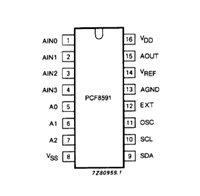IDT77V1254L25
Transmission Description
ꢀꢁꢂꢁ
ꢃꢃꢃꢃ
ꢃꢄꢃꢃ
ꢄꢃꢃꢃ
ꢄꢄꢃꢃ
ꢅꢆꢇꢈꢉꢊ
ꢄꢃꢄꢃꢄ
ꢃꢃꢄꢄꢄ
ꢄꢃꢃꢄꢃ
ꢄꢃꢄꢄꢄ
ꢀꢁꢂꢁ
ꢃꢃꢃꢄ
ꢃꢄꢃꢄ
ꢄꢃꢃꢄ
ꢄꢄꢃꢄ
ꢅꢆꢇꢈꢉꢊ
ꢃꢄꢃꢃꢄ
ꢃꢄꢄꢃꢄ
ꢄꢄꢃꢃꢄ
ꢄꢄꢄꢃꢄ
Refer to Figure 4. Cell transmission begins with the PHY-ATM Inter-
face. An ATM layer device transfers a cell into the 77V1254L25 across
the Utopia or DPI transmit bus. This cell enters a 3-cell deep transmit
FIFO. Once a complete cell is in the FIFO, transmission begins by
passing the cell, four bits (MSB first) at a time to the 'Scrambler'.
The 'Scrambler' takes each nibble of data and exclusive-ORs them
against the 4 high order bits (X(t), X(t-1), X(t-2), X(t-3)) of a 10 bit
pseudo-random nibble generator (PRNG). Its function is to provide the
appropriate frequency distribution for the signal across the line.
ꢀꢁꢂꢁ
ꢃꢃꢄꢃ
ꢃꢄꢄꢃ
ꢄꢃꢄꢃ
ꢄꢄꢄꢃ
ꢅꢆꢇꢈꢉꢊ
ꢃꢄꢃꢄꢃ
ꢃꢄꢄꢄꢃ
ꢄꢄꢃꢄꢃ
ꢄꢄꢄꢄꢃ
ꢀꢁꢂꢁ
ꢃꢃꢄꢄ
ꢃꢄꢄꢄ
ꢄꢃꢄꢄ
ꢄꢄꢄꢄ
ꢅꢆꢇꢈꢉꢊ
ꢃꢄꢃꢄꢄ
ꢃꢄꢄꢄꢄ
ꢄꢄꢃꢄꢄ
ꢄꢄꢄꢄꢄ
The PRNG is clocked every time a nibble is processed, regardless of
whether the processed nibble is part of a data or command byte. Note
however that only data nibbles are scrambled. The entire command byte
(X _C) is NOT scrambled before it's encoded (see diagram for illustra-
tion). The PRNG is based upon the following polynomial:
ꢑꢒꢃꢒ ꢓꢔꢕ ꢃꢒꢁ
ꢋꢅꢌꢍꢎꢏ ꢐ ꢃꢃꢃꢄꢃ
This encode/decode implementation has several very desirable prop-
erties. Among them is the fact that the output data bits can be repre-
sented by a set of relatively simple symbols;
10
7
X + X + 1
Run length is limited to <= 5;
With this polynomial, the four output data bits (D3, D2, D1, D0) will be
Disparity never exceeds +/- 1.
generated from the following equations:
On the receiver, the decoder determines from the received symbols
whether a timing marker command (X_8) or a start-of-cell command was
sent (X_X or X_4). If a start-of-cell command is detected, the next 53
bytes received are decoded and forwarded to the descrambler. (See TC
Receive Block Diagram, Figure 5).
D3 = d3 xor X(t-3)
D2 = d2 xor X(t-2)
D1 = d1 xor X(t-1)
D0 = d0 xor X(t)
The following nibble is scrambled with X(t+4), X(t+3), X(t+2), and
X(t+1).
A scrambler lock between the transmitter and receiver occurs each
time an X_X command is sent. An X_X command is initiated only at the
beginning of a cell transfer after the PRNG has cycled through all of its
10
states (2 - 1 = 1023 states). The first valid ATM data cell transmitted
after power on will also be accompanied with an X_X command byte.
Each time an X_X command byte is sent, the first nibble after the last
escape (X) nibble is XOR'd with 1111b (PRNG = 3FFx).
Because a timing marker command (X_8) may occur at any time, the
possibility of a reset PRNG start-of-cell command and a timing marker
command occurring consecutively does exist (e.g. X_X_X_8). In this
case, the detection of the last two consecutive escape (X) nibbles will
cause the PRNG to reset to its initial 3FFx state. Therefore, the PRNG is
clocked only after the first nibble of the second consecutive escape pair.
Once the data nibbles have been scrambled using the PRNG, the
nibbles are further encoded using a 4b/5b process. The 4b/5b scheme
ensures that an appropriate number of signal transitions occur on the
line. A total of seventeen 5-bit symbols are used to represent the sixteen
4-bit data nibbles and the one escape (X) nibble. The table below lists
the 4-bit data with their corresponding 5-bit symbols:
3 of 47
September 21, 2001






 STM32F030C6芯片介绍:主要参数分析、引脚配置说明、功耗及封装
STM32F030C6芯片介绍:主要参数分析、引脚配置说明、功耗及封装

 PCF8591数据手册解读:参数、引脚说明
PCF8591数据手册解读:参数、引脚说明

 一文带你了解ss8050参数、引脚配置、应用指南
一文带你了解ss8050参数、引脚配置、应用指南

 深入解析AD7606高性能多通道模数转换器:资料手册参数分析
深入解析AD7606高性能多通道模数转换器:资料手册参数分析
